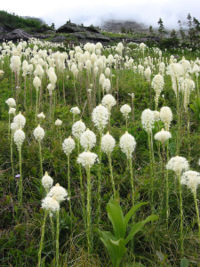Xerophyllum tenax
| Xerophyllum tenax subsp. var. | bear grass, squaw grass, soap grass, quip-quip, Indian basket grass | |||||||||||||||||||||||||||||||||||||||||||||||||||||||
|---|---|---|---|---|---|---|---|---|---|---|---|---|---|---|---|---|---|---|---|---|---|---|---|---|---|---|---|---|---|---|---|---|---|---|---|---|---|---|---|---|---|---|---|---|---|---|---|---|---|---|---|---|---|---|---|---|

|
|
| ||||||||||||||||||||||||||||||||||||||||||||||||||||||
| ||||||||||||||||||||||||||||||||||||||||||||||||||||||||
| Standard Cyclopedia of Horticulture |
|---|
|
Xerophyllum tenax, Nutt. Two to 5 ft. high: lvs. about 2 lines wide: raceme 1-2 ft. long; pedicels longer: perianth segms. scarcely equaling the stamens. Calif. to Brit. Col. June, July. B.R. 1613 (erroneously as X. setifolium).
|
Xerophyllum tenax (syn. Helonias tenax) is a grasslike perennial in the family Melanthiaceae, closely related to lilies. It is known by several common names, including bear grass, squaw grass, soap grass, quip-quip, and Indian basket grass. It can grow to 15-150 cm in height and grows in bunches with the leaves wrapped around and extending from a small stem at ground level. The leaves are 30-100 cm long and 2-6 mm wide, dull olive green with toothed edges. The slightly fragrant white flowers emerge from a tall stalk that bolts from the base. When the flowers are in bloom they are tightly packed at the tip of the stalk like an upright club. The plant is found mostly in western North America from British Columbia south to California and east to Wyoming, in subalpine meadows and coastal mountains, and also on low ground in the California coastal fog belt. It is common on the Olympic Peninsula and in the Cascades, northern Sierra Nevada and Rockies.
Cultivation
Propagation
Pests and diseases
Species
Gallery
If you have a photo of this plant, please upload it! Plus, there may be other photos available for you to add.
-
photo 1
-
photo 2
-
photo 3
References
- Standard Cyclopedia of Horticulture, by L. H. Bailey, MacMillan Co., 1963
External links
- w:Xerophyllum tenax. Some of the material on this page may be from Wikipedia, under the Creative Commons license.
- Xerophyllum tenax QR Code (Size 50, 100, 200, 500)
